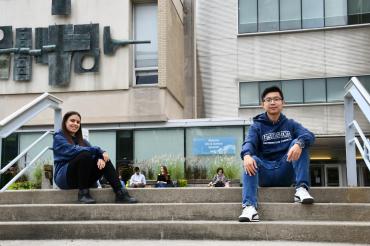Sidney Smith Hall transformation project to create space for innovative learning, teaching and research

Veronica Bergstrom and Andrew Yin sit outside Sidney Smith Hall, which will undergo a transformative redevelopment project that will create a new home for U of T's Faculty of Arts & Science (photo by Diana Tyszko)
Published: November 10, 2021
The University of Toronto’s Faculty of Arts & Science has announced plans to redevelop Sidney Smith Hall to create a transformative space for innovative learning, teaching and research.
The revitalization project, currently in early planning stages, will help redefine the university’s largest academic division – and one of the largest in North America – by creating a new home for it on the St. George campus.
“Our goal is to create a contemporary, accessible and state-of-the-art space for our students, staff and faculty, and the wider community,” says Melanie Woodin, dean of the Faculty of Arts & Science. “As dean, I am really pleased to launch this exciting project that will advance and grow our teaching and research mission.”
The project will provide a new facility while extensively renovating the north vertical portion of the building. It will address much-needed academic, administrative, student and ancillary space needs. They include: lounge, study and collaboration spaces; a community marketplace to gather and eat; event and meeting space; and state-of-the-art classrooms.
“As the University of Toronto heads into its third century, we envision this new footprint will be a magnet for local and international engagement, and a hub to inspire thought-provoking events and respectful, authentic dialogue on the critical issues facing our society,” adds Woodin.
The renewal project aims to create a more recognizable identity for the Faculty of Arts & Science and foster greater connections across its community, comprising more than 70 academic departments, schools, centres and institutes in 40 academic buildings and colleges across the St. George campus.
“It’s really exciting to hear about this project. Better classrooms, more food options, more event space and the addition of common areas outside are all really beneficial to students in the long run,” says PhD student Veronica Bergstrom of the department of psychology.
U of T ’s Faculty of Arts & Science has grown in breadth and depth since the building opened in 1960. While the site is one of the most well-travelled places on the St. George campus due to its central location and teaching space, the building’s age and size are constraints on the faculty’s ability to fully realize its potential as a research and leadership centre locally, nationally and internationally.
The university will also address the building’s accessibility and improve student spaces as a central part of its redevelopment while designing and building a high-performance net-zero carbon certified building.
“From a user’s point of view, it's unfortunately difficult to navigate,” says undergraduate student Andrew Yin, who is in his final year at Innis College. “I've gotten lost in the basement and lost trying to get to the food hall; some areas are not connected. There are a lot of areas where improvement is needed. I'm quite glad the university has not only recognized these issues and is trying to rebuild the site, but also considering the students point of view and trying to hold consultation sessions.”
Scott Mabury, vice-president of operations and real estate partnerships, says like all major capital development projects, the process is lengthy and will include opportunities for viewing models, renderings and engagement with design ideas as architects are selected and the plan is developed over the next several years.
“This plan will allow growth for the Faculty of Arts & Science well into the future,” says Mabury. “It will be a thoughtfully designed, sustainable and accessible building complemented with a large, and welcoming open space serving our entire community for generations to come.”
Design team selection for this project is scheduled to take place over several months, starting in spring 2022.



